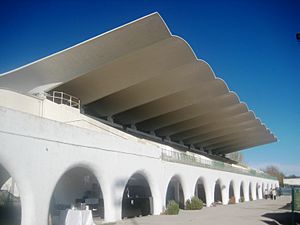Eduardo Torroja facts for kids
Quick facts for kids
Eduardo Torroja
|
|
|---|---|
| Born | 27 August 1899 |
| Died | 15 June 1961 (aged 61) |
| Nationality | Spanish |
| Occupation | Engineer |
| Engineering career | |
| Projects | Tempul cable-stayed aqueduct |
| Significant advance | Concrete-shell structures |
| Awards | Wilhelm Exner Medal, 1954 |
Eduardo Torroja y Miret (born August 27, 1899 – died June 15, 1961) was a famous Spanish engineer. He was a pioneer in designing amazing buildings using thin, curved concrete shapes, known as concrete shells. He was also known as the 1st Marques of Torroja.
Contents
Early Life and Education
Eduardo Torroja was born in Madrid, Spain. He studied civil engineering there. This is a type of engineering focused on designing and building things like roads, bridges, and buildings.
Building a Career

In 1923, Torroja started working for a company called Hidrocivil. He helped plan and manage many different projects. These included building bridge foundations, bridges, water systems, and city buildings.
One of his first big projects was the Tempul aqueduct in 1926. An aqueduct is like a bridge that carries water. For this project, he used special pre-stressed concrete beams. In 1928, he opened his own engineering office.
Working with Architects
In 1929, Torroja joined a team working on the Madrid University City project. He worked closely with an architect named Manuel Sánchez Arcas. They both liked trying new and different architectural designs.
Their first project together was a pavilion for the university in 1931. They also worked on the university's heating plant and the clinical hospital.
Algeciras Market Hall
Sánchez Arcas and Torroja designed the market hall in Algeciras in 1932. Its roof was a special semi-spherical (half-dome) concrete shell. This roof was only about 9 centimeters (3.5 inches) thick! It was 47.5 meters (156 feet) high and supported by eight pillars. Many people consider this market hall to be one of Torroja's best works.
New Ideas in Construction
Sánchez Arcas and Torroja also started a magazine called Hormigón y Acero, which means Concrete and Steel. In 1934, they created the Technical Institute of Construction and Building (ITCE). This group was dedicated to finding and using new technical ideas in building structures.
In 1952, Eduardo Torroja helped create the Comité Européen du Béton. This group aimed to organize research on concrete structures in Europe after World War II. It is now known as the Fédération Internationale du Béton.
Famous Designs
Eduardo Torroja designed many unique structures. He created a thin-shell water tower in Fedala. He also designed the roof of the "La Zarzuela" racetrack in Madrid. This roof had a special curved shape called a hyperboloid.
He was also skilled at using steel, like in the roof of the Football Stadium in Barcelona (1943). Torroja designed innovative buildings in many parts of the world, including Morocco and Latin America. He wrote books like Philosophy of Structures (1958) and The Structures of Eduardo Torroja (1958).
His Vision for Structures
Torroja believed that a building's design should show the personality of the person who created it. He thought that every curve and detail in a structure could reflect important moments in a designer's life. He found new ways to look at structures. He also discovered how to make buildings stronger while still keeping them beautiful. Torroja often included his artistic ideas in his designs.
Challenges and Innovations
In the 1920s, Europe was recovering from war. Spain had limited steel supplies. This led Torroja to explore other building materials. He became famous for his work with reinforced concrete. This material combines concrete with steel bars to make it very strong. His developments in reinforced concrete are still highly regarded today.
See also
 In Spanish: Eduardo Torroja Miret para niños
In Spanish: Eduardo Torroja Miret para niños


